Air bag Hyundai Elantra 2018 Owner's Manual
[x] Cancel search | Manufacturer: HYUNDAI, Model Year: 2018, Model line: Elantra, Model: Hyundai Elantra 2018Pages: 526, PDF Size: 17.2 MB
Page 10 of 526
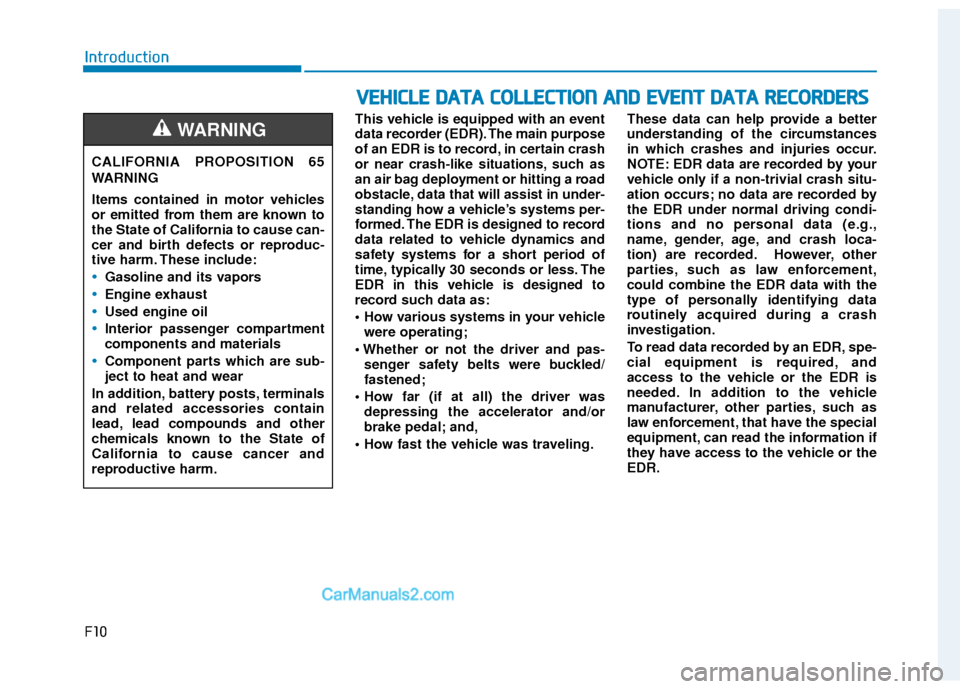
F10
Introduction
This vehicle is equipped with an event
data recorder (EDR). The main purpose
of an EDR is to record, in certain crash
or near crash-like situations, such as
an air bag deployment or hitting a road
obstacle, data that will assist in under-
standing how a vehicle’s systems per-
formed. The EDR is designed to record
data related to vehicle dynamics and
safety systems for a short period of
time, typically 30 seconds or less. The
EDR in this vehicle is designed to
record such data as:
were operating;
senger safety belts were buckled/
fastened;
depressing the accelerator and/or
brake pedal; and,
These data can help provide a better
understanding of the circumstances
in which crashes and injuries occur.
NOTE: EDR data are recorded by your
vehicle only if a non-trivial crash situ-
ation occurs; no data are recorded by
the EDR under normal driving condi-
tions and no personal data (e.g.,
name, gender, age, and crash loca-
tion) are recorded. However, other
parties, such as law enforcement,
could combine the EDR data with the
type of personally identifying data
routinely acquired during a crash
investigation.
To read data recorded by an EDR, spe-
cial equipment is required, and
access to the vehicle or the EDR is
needed. In addition to the vehicle
manufacturer, other parties, such as
law enforcement, that have the special
equipment, can read the information if
they have access to the vehicle or the
EDR.
V V
E
EH
H I
IC
C L
LE
E
D
D A
A T
TA
A
C
C O
O L
LL
LE
E C
CT
T I
IO
O N
N
A
A N
N D
D
E
E V
V E
EN
N T
T
D
D A
A T
TA
A
R
R E
EC
CO
O R
RD
D E
ER
R S
S
CALIFORNIA PROPOSITION 65
WARNING
Items contained in motor vehicles
or emitted from them are known to
the State of California to cause can-
cer and birth defects or reproduc-
tive harm. These include:
Gasoline and its vapors
Engine exhaust
Used engine oil
Interior passenger compartment
components and materials
Component parts which are sub-
ject to heat and wear
In addition, battery posts, terminals
and related accessories contain
lead, lead compounds and other
chemicals known to the State of
California to cause cancer and
reproductive harm.
WARNING
Page 16 of 526
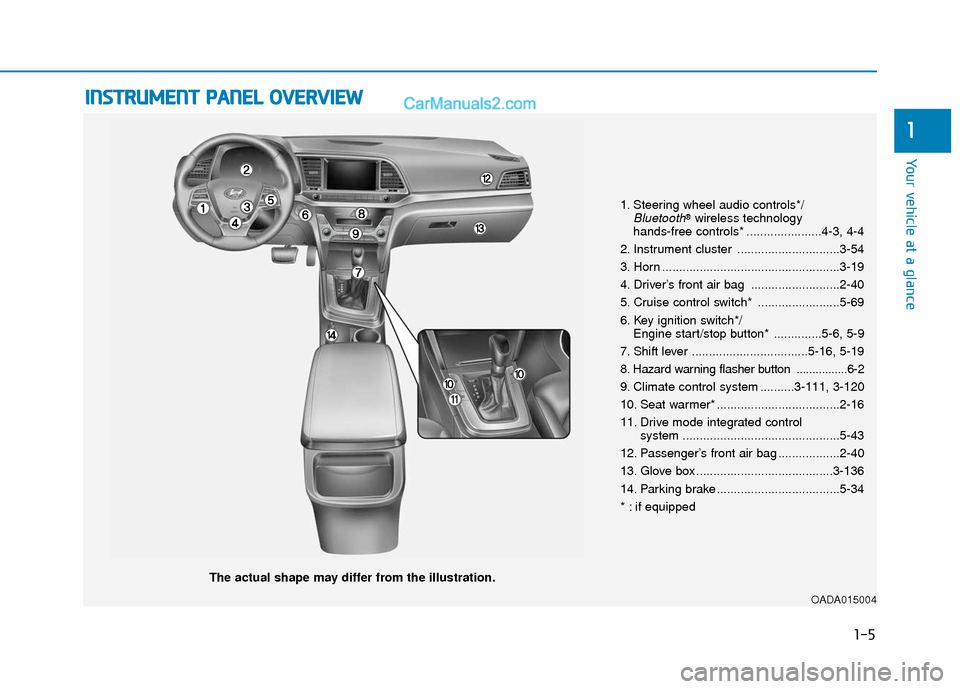
I
IN
N S
ST
T R
R U
U M
M E
EN
N T
T
P
P A
A N
N E
EL
L
O
O V
VE
ER
R V
V I
IE
E W
W
The actual shape may differ from the illustration.
1-5
Your vehicle at a glance
1
1. Steering wheel audio controls*/Bluetooth®wireless technology
hands-free controls* ......................4-3, 4-4
2. Instrument cluster ..............................3-54
3. Horn ....................................................3-19
4. Driver’s front air bag ..........................2-40
5. Cruise control switch* ........................5-69
6. Key ignition switch*/ Engine start/stop button* ..............5-6, 5-9
7. Shift lever ..................................5-16, 5-19
8
. Hazard warning flasher button ................6-2
9. Climate control system ..........3-111, 3-120
10. Seat warmer* ....................................2-16
11. Drive mode integrated control system ..............................................5-43
12. Passenger’s front air bag ..................2-40
13. Glove box ........................................3-136
14. Parking brake ....................................5-34
* : if equipped
OADA015004
Page 18 of 526
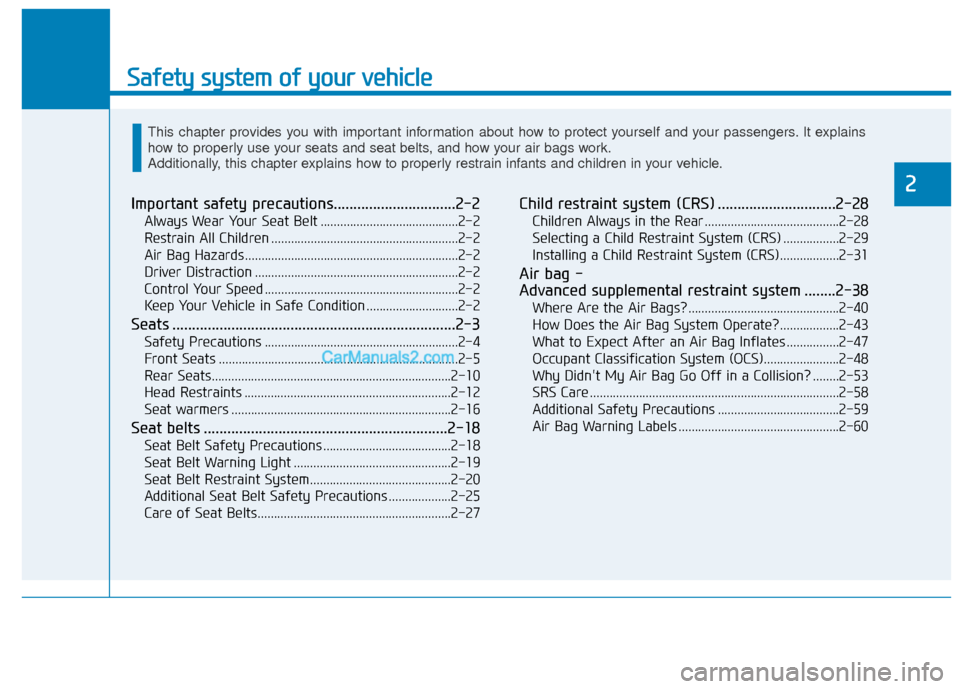
Safety system of your vehicle
Important safety precautions...............................2-2
Always Wear Your Seat Belt ..........................................2-2
Restrain All Children .........................................................2-2
Air Bag Hazards .................................................................2-2
Driver Distraction ..............................................................2-2
Control Your Speed ...........................................................2-2
Keep Your Vehicle in Safe Condition ............................2-2
Seats ........................................................................\
2-3
Safety Precautions ...........................................................2-4
Front Seats ........................................................................\
.2-5
Rear Seats........................................................................\
.2-10
Head Restraints ...............................................................2-12
Seat warmers ...................................................................2-16
Seat belts ..............................................................2-18
Seat Belt Safety Precautions .......................................2-18
Seat Belt Warning Light ................................................2-19
Seat Belt Restraint System...........................................2-20
Additional Seat Belt Safety Precautions ...................2-25
Care of Seat Belts...........................................................2-27
Child restraint system (CRS) ..............................2-28
Children Always in the Rear .........................................2-28
Selecting a Child Restraint System (CRS) .................2-29
Installing a Child Restraint System (CRS)..................2-31
Air bag -
Advanced supplemental restraint system ........2-38
Where Are the Air Bags? ..............................................2-40
How Does the Air Bag System Operate?..................2-43
What to Expect After an Air Bag Inflates ................2-47
Occupant Classification System (OCS).......................2-48
Why Didn't My Air Bag Go Off in a Collision? ........2-53
SRS Care ........................................................................\
....2-58
Additional Safety Precautions .....................................2-59
Air Bag Warning Labels .................................................2-60
This chapter provides you with important information about how to protect yourself and your passengers. It explains
how to properly use your seats and seat belts, and how your air bags work.
Additionally, this chapter explains how to properly restrain infants and children in your vehicle.
2
Page 19 of 526
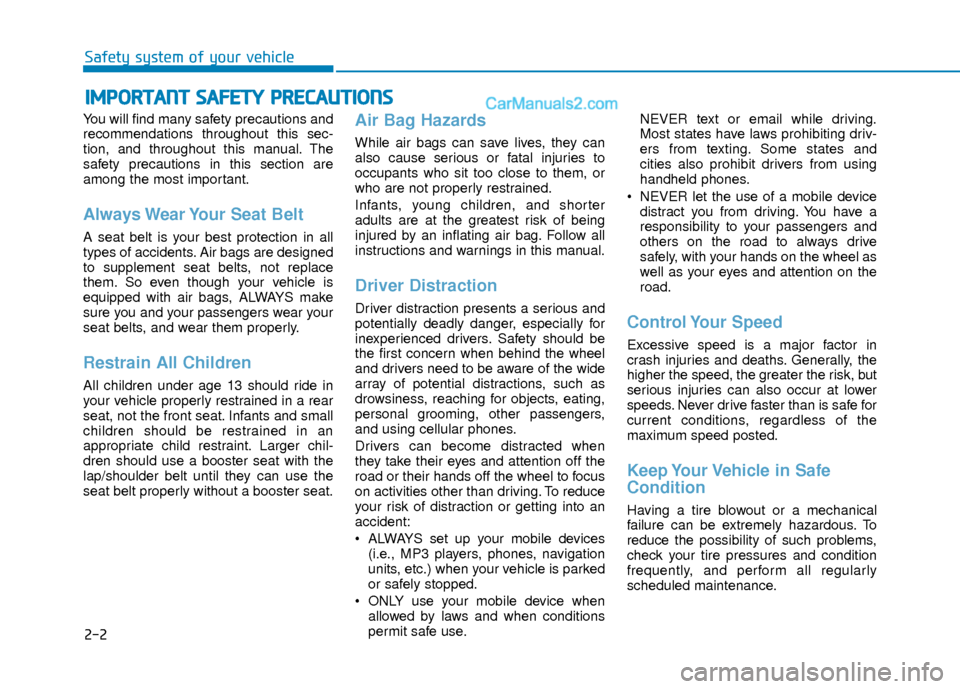
2-2
You will find many safety precautions and
recommendations throughout this sec-
tion, and throughout this manual. The
safety precautions in this section are
among the most important.
Always Wear Your Seat Belt
A seat belt is your best protection in all
types of accidents. Air bags are designed
to supplement seat belts, not replace
them. So even though your vehicle is
equipped with air bags, ALWAYS make
sure you and your passengers wear your
seat belts, and wear them properly.
Restrain All Children
All children under age 13 should ride in
your vehicle properly restrained in a rear
seat, not the front seat. Infants and small
children should be restrained in an
appropriate child restraint. Larger chil-
dren should use a booster seat with the
lap/shoulder belt until they can use the
seat belt properly without a booster seat.
Air Bag Hazards
While air bags can save lives, they can
also cause serious or fatal injuries to
occupants who sit too close to them, or
who are not properly restrained.
Infants, young children, and shorter
adults are at the greatest risk of being
injured by an inflating air bag. Follow all
instructions and warnings in this manual.
Driver Distraction
Driver distraction presents a serious and
potentially deadly danger, especially for
inexperienced drivers. Safety should be
the first concern when behind the wheel
and drivers need to be aware of the wide
array of potential distractions, such as
drowsiness, reaching for objects, eating,
personal grooming, other passengers,
and using cellular phones.
Drivers can become distracted when
they take their eyes and attention off the
road or their hands off the wheel to focus
on activities other than driving. To reduce
your risk of distraction or getting into an
accident:
• ALWAYS set up your mobile devices
(i.e., MP3 players, phones, navigation
units, etc.) when your vehicle is parked
or safely stopped.
ONLY use your mobile device when allowed by laws and when conditions
permit safe use. NEVER text or email while driving.
Most states have laws prohibiting driv-
ers from texting. Some states and
cities also prohibit drivers from using
handheld phones.
NEVER let the use of a mobile device distract you from driving. You have a
responsibility to your passengers and
others on the road to always drive
safely, with your hands on the wheel as
well as your eyes and attention on the
road.Control Your Speed
Excessive speed is a major factor in
crash injuries and deaths. Generally, the
higher the speed, the greater the risk, but
serious injuries can also occur at lower
speeds. Never drive faster than is safe for
current conditions, regardless of the
maximum speed posted.
Keep Your Vehicle in Safe
Condition
Having a tire blowout or a mechanical
failure can be extremely hazardous. To
reduce the possibility of such problems,
check your tire pressures and condition
frequently, and perform all regularly
scheduled maintenance.
I IM
M P
PO
O R
RT
TA
A N
N T
T
S
S A
A F
FE
E T
T Y
Y
P
P R
R E
EC
CA
A U
U T
TI
IO
O N
NS
S
Safety system of your vehicle
Page 21 of 526
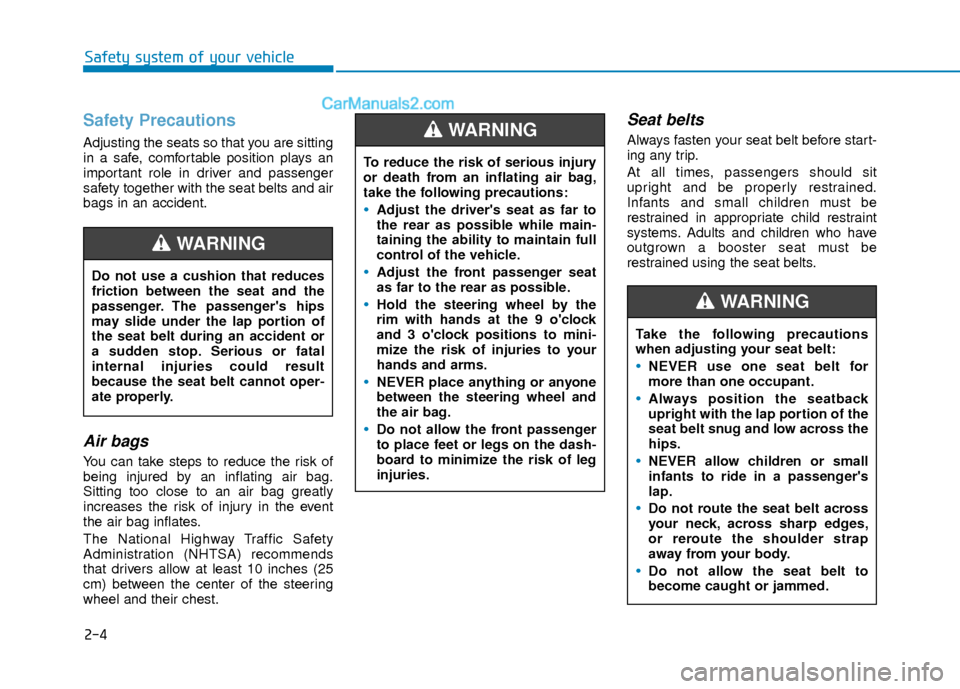
2-4
Safety system of your vehicle
Safety Precautions
Adjusting the seats so that you are sitting
in a safe, comfortable position plays an
important role in driver and passenger
safety together with the seat belts and air
bags in an accident.
Air bags
You can take steps to reduce the risk of
being injured by an inflating air bag.
Sitting too close to an air bag greatly
increases the risk of injury in the event
the air bag inflates.
The National Highway Traffic Safety
Administration (NHTSA) recommends
that drivers allow at least 10 inches (25
cm) between the center of the steering
wheel and their chest.
Seat belts
Always fasten your seat belt before start-
ing any trip.
At all times, passengers should sit
upright and be properly restrained.
Infants and small children must be
restrained in appropriate child restraint
systems. Adults and children who have
outgrown a booster seat must be
restrained using the seat belts.
Do not use a cushion that reduces
friction between the seat and the
passenger. The passenger's hips
may slide under the lap portion of
the seat belt during an accident or
a sudden stop. Serious or fatal
internal injuries could result
because the seat belt cannot oper-
ate properly.
WARNING
To reduce the risk of serious injury
or death from an inflating air bag,
take the following precautions:
•Adjust the driver's seat as far to
the rear as possible while main-
taining the ability to maintain full
control of the vehicle.
Adjust the front passenger seat
as far to the rear as possible.
Hold the steering wheel by the
rim with hands at the 9 o'clock
and 3 o'clock positions to mini-
mize the risk of injuries to your
hands and arms.
NEVER place anything or anyone
between the steering wheel and
the air bag.
Do not allow the front passenger
to place feet or legs on the dash-
board to minimize the risk of leg
injuries.
WARNING
Take the following precautions
when adjusting your seat belt:
NEVER use one seat belt for
more than one occupant.
Always position the seatback
upright with the lap portion of the
seat belt snug and low across the
hips.
NEVER allow children or small
infants to ride in a passenger's
lap.
Do not route the seat belt across
your neck, across sharp edges,
or reroute the shoulder strap
away from your body.
Do not allow the seat belt to
become caught or jammed.
WARNING
Page 23 of 526
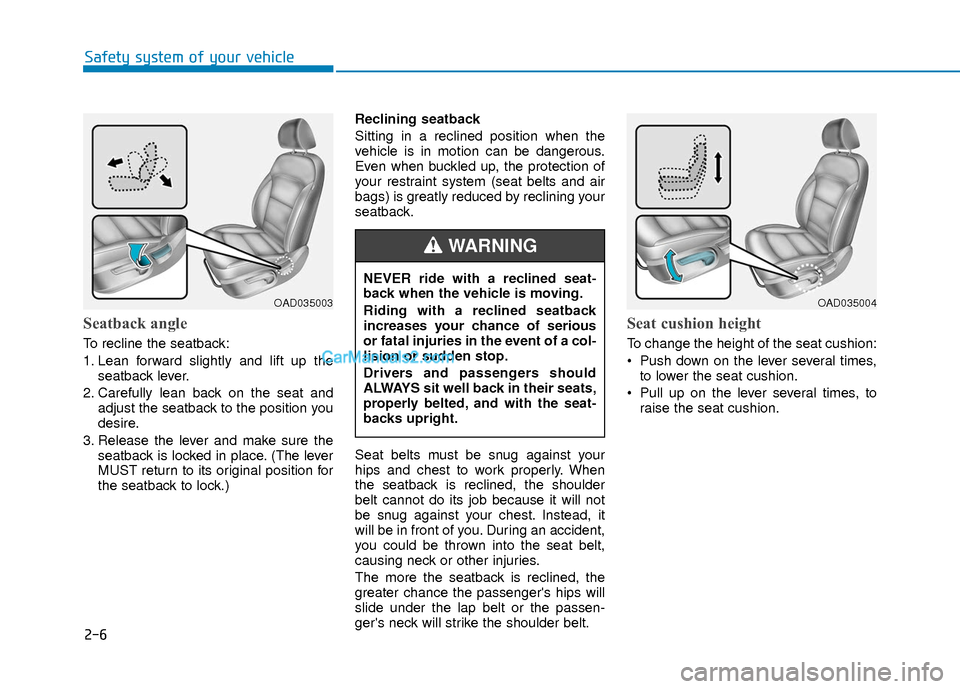
2-6
Safety system of your vehicle
Seatback angle
To recline the seatback:
1. Lean forward slightly and lift up theseatback lever.
2. Carefully lean back on the seat and adjust the seatback to the position you
desire.
3. Release the lever and make sure the seatback is locked in place. (The lever
MUST return to its original position for
the seatback to lock.) Reclining seatback
Sitting in a reclined position when the
vehicle is in motion can be dangerous.
Even when buckled up, the protection of
your restraint system (seat belts and air
bags) is greatly reduced by reclining your
seatback.
Seat belts must be snug against your
hips and chest to work properly. When
the seatback is reclined, the shoulder
belt cannot do its job because it will not
be snug against your chest. Instead, it
will be in front of you. During an accident,
you could be thrown into the seat belt,
causing neck or other injuries.
The more the seatback is reclined, the
greater chance the passenger's hips will
slide under the lap belt or the passen-
ger's neck will strike the shoulder belt.
Seat cushion height
To change the height of the seat cushion:
Push down on the lever several times,
to lower the seat cushion.
Pull up on the lever several times, to raise the seat cushion.
OAD035003OAD035004
NEVER ride with a reclined seat-
back when the vehicle is moving.
Riding with a reclined seatback
increases your chance of serious
or fatal injuries in the event of a col-
lision or sudden stop.
Drivers and passengers should
ALWAYS sit well back in their seats,
properly belted, and with the seat-
backs upright.
WARNING
Page 25 of 526
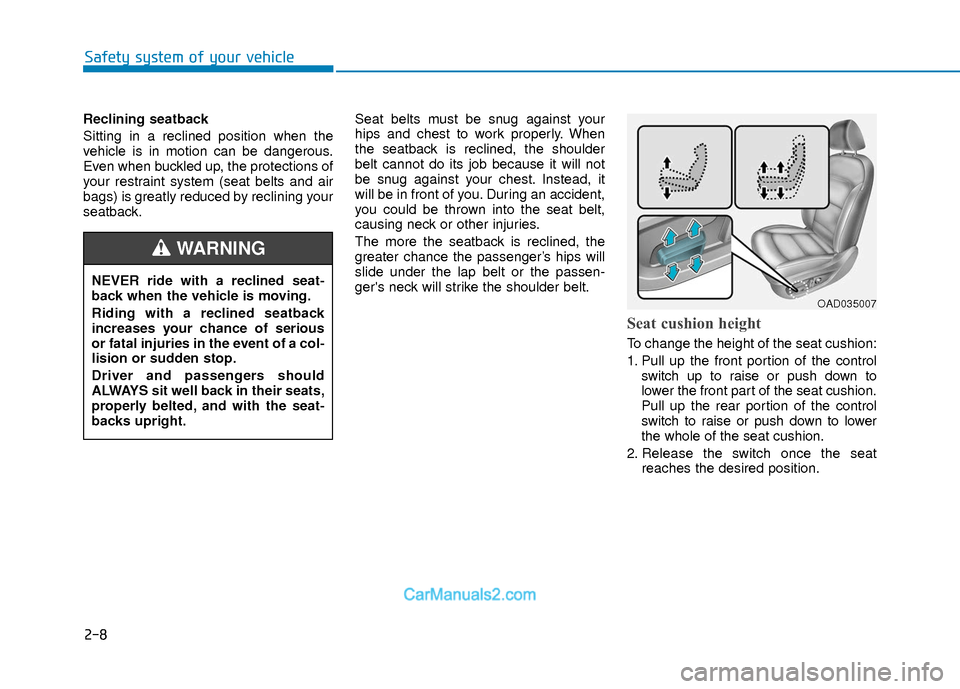
2-8
Safety system of your vehicle
Reclining seatback
Sitting in a reclined position when the
vehicle is in motion can be dangerous.
Even when buckled up, the protections of
your restraint system (seat belts and air
bags) is greatly reduced by reclining your
seatback.Seat belts must be snug against your
hips and chest to work properly. When
the seatback is reclined, the shoulder
belt cannot do its job because it will not
be snug against your chest. Instead, it
will be in front of you. During an accident,
you could be thrown into the seat belt,
causing neck or other injuries.
The more the seatback is reclined, the
greater chance the passenger’s hips will
slide under the lap belt or the passen-
ger's neck will strike the shoulder belt.
Seat cushion height
To change the height of the seat cushion:
1. Pull up the front portion of the control
switch up to raise or push down to
lower the front part of the seat cushion.
Pull up the rear portion of the control
switch to raise or push down to lower
the whole of the seat cushion.
2. Release the switch once the seat reaches the desired position.
NEVER ride with a reclined seat-
back when the vehicle is moving.
Riding with a reclined seatback
increases your chance of serious
or fatal injuries in the event of a col-
lision or sudden stop.
Driver and passengers should
ALWAYS sit well back in their seats,
properly belted, and with the seat-
backs upright.
WARNING
OAD035007
Page 35 of 526
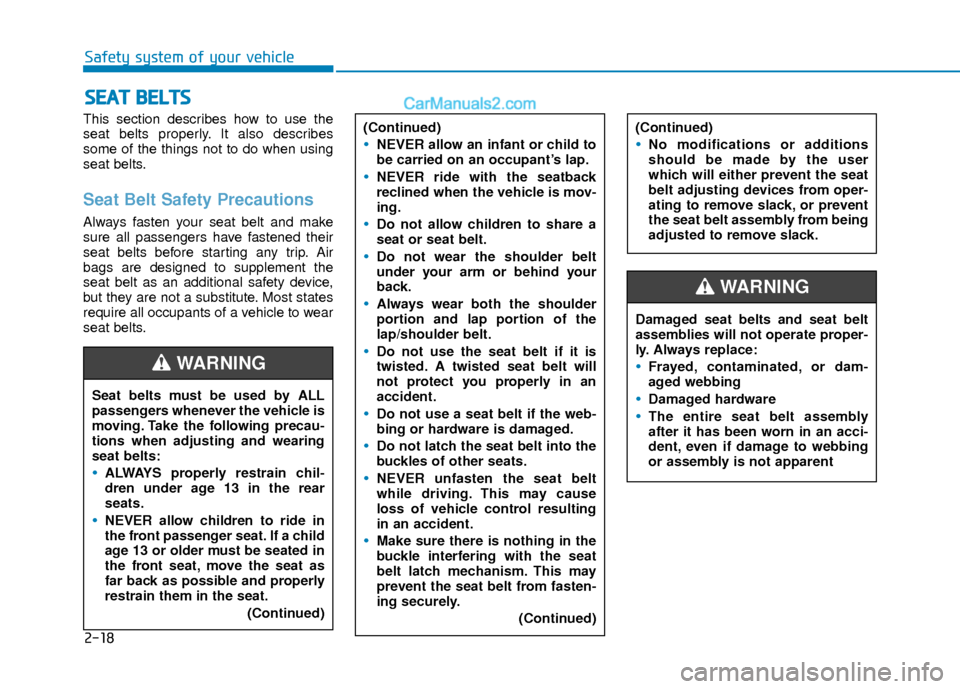
2-18
Safety system of your vehicle
This section describes how to use the
seat belts properly. It also describes
some of the things not to do when using
seat belts.
Seat Belt Safety Precautions
Always fasten your seat belt and make
sure all passengers have fastened their
seat belts before starting any trip. Air
bags are designed to supplement the
seat belt as an additional safety device,
but they are not a substitute. Most states
require all occupants of a vehicle to wear
seat belts.
S SE
E A
A T
T
B
B E
EL
LT
T S
S
Seat belts must be used by ALL
passengers whenever the vehicle is
moving. Take the following precau-
tions when adjusting and wearing
seat belts:
ALWAYS properly restrain chil-
dren under age 13 in the rear
seats.
NEVER allow children to ride in
the front passenger seat. If a child
age 13 or older must be seated in
the front seat, move the seat as
far back as possible and properly
restrain them in the seat.
(Continued)
WARNING
(Continued)
NEVER allow an infant or child to
be carried on an occupant’s lap.
NEVER ride with the seatback
reclined when the vehicle is mov-
ing.
Do not allow children to share a
seat or seat belt.
Do not wear the shoulder belt
under your arm or behind your
back.
Always wear both the shoulder
portion and lap portion of the
lap/shoulder belt.
Do not use the seat belt if it is
twisted. A twisted seat belt will
not protect you properly in an
accident.
Do not use a seat belt if the web-
bing or hardware is damaged.
Do not latch the seat belt into the
buckles of other seats.
NEVER unfasten the seat belt
while driving. This may cause
loss of vehicle control resulting
in an accident.
Make sure there is nothing in the
buckle interfering with the seat
belt latch mechanism. This may
prevent the seat belt from fasten-
ing securely.(Continued)
(Continued)
No modifications or additions
should be made by the user
which will either prevent the seat
belt adjusting devices from oper-
ating to remove slack, or prevent
the seat belt assembly from being
adjusted to remove slack.
Damaged seat belts and seat belt
assemblies will not operate proper-
ly. Always replace:
Frayed, contaminated, or dam-
aged webbing
Damaged hardware
The entire seat belt assembly
after it has been worn in an acci-
dent, even if damage to webbing
or assembly is not apparent
WARNING
Page 40 of 526
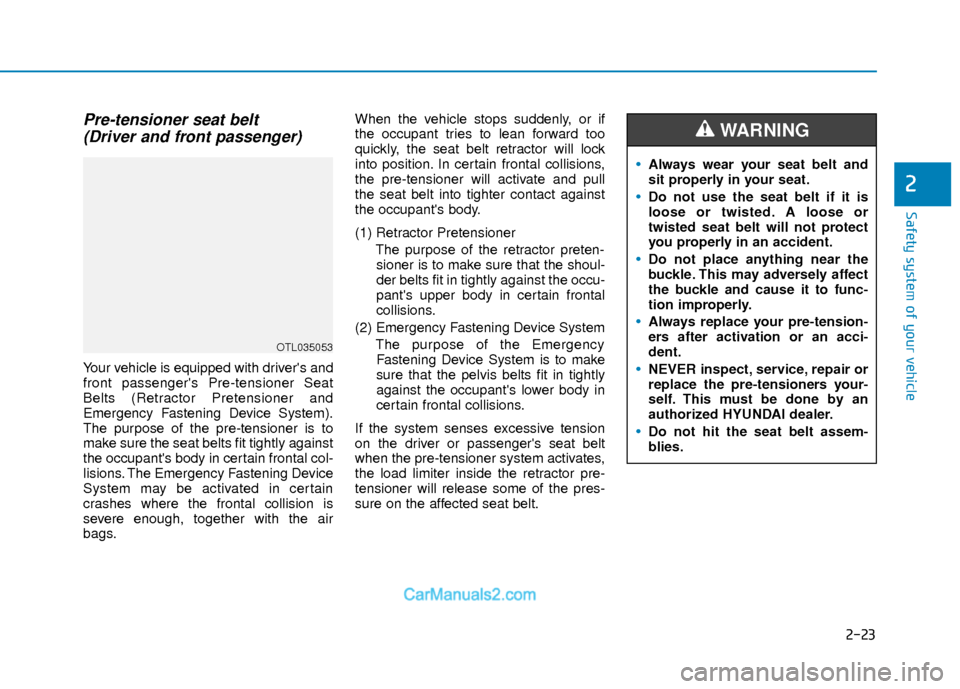
2-23
Safety system of your vehicle
2
Pre-tensioner seat belt (Driver and front passenger)
Your vehicle is equipped with driver's and
front passenger's Pre-tensioner Seat
Belts (Retractor Pretensioner and
Emergency Fastening Device System).
The purpose of the pre-tensioner is to
make sure the seat belts fit tightly against
the occupant's body in certain frontal col-
lisions. The Emergency Fastening Device
System may be activated in certain
crashes where the frontal collision is
severe enough, together with the air
bags. When the vehicle stops suddenly, or if
the occupant tries to lean forward too
quickly, the seat belt retractor will lock
into position. In certain frontal collisions,
the pre-tensioner will activate and pull
the seat belt into tighter contact against
the occupant's body.
(1) Retractor Pretensioner
The purpose of the retractor preten-sioner is to make sure that the shoul-
der belts fit in tightly against the occu-
pant's upper body in certain frontal
collisions.
(2) Emergency Fastening Device System The purpose of the EmergencyFastening Device System is to make
sure that the pelvis belts fit in tightly
against the occupant's lower body in
certain frontal collisions.
If the system senses excessive tension
on the driver or passenger's seat belt
when the pre-tensioner system activates,
the load limiter inside the retractor pre-
tensioner will release some of the pres-
sure on the affected seat belt.
OTL035053
Always wear your seat belt and
sit properly in your seat.
Do not use the seat belt if it is
loose or twisted. A loose or
twisted seat belt will not protect
you properly in an accident.
Do not place anything near the
buckle. This may adversely affect
the buckle and cause it to func-
tion improperly.
Always replace your pre-tension-
ers after activation or an acci-
dent.
NEVER inspect, service, repair or
replace the pre-tensioners your-
self. This must be done by an
authorized HYUNDAI dealer.
Do not hit the seat belt assem-
blies.
WARNING
Page 41 of 526
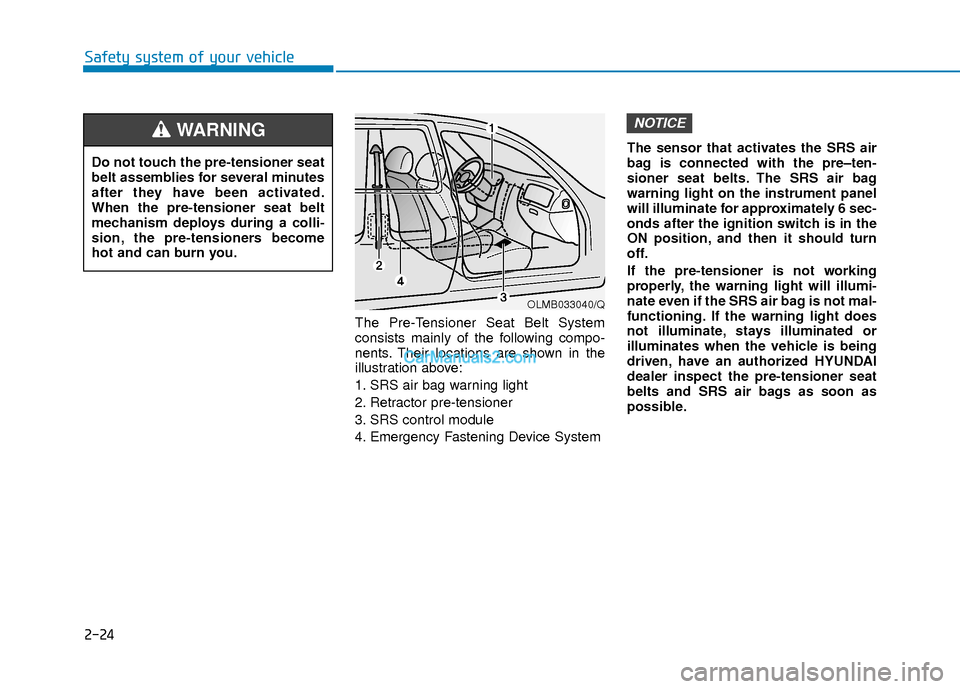
2-24
Safety system of your vehicle
The Pre-Tensioner Seat Belt System
consists mainly of the following compo-
nents. Their locations are shown in the
illustration above:
1. SRS air bag warning light
2. Retractor pre-tensioner
3. SRS control module
4. Emergency Fastening Device SystemThe sensor that activates the SRS air
bag is connected with the pre–ten-
sioner seat belts. The SRS air bag
warning light on the instrument panel
will illuminate for approximately 6 sec-
onds after the ignition switch is in the
ON position, and then it should turn
off.
If the pre-tensioner is not working
properly, the warning light will illumi-
nate even if the SRS air bag is not mal-
functioning. If the warning light does
not illuminate, stays illuminated or
illuminates when the vehicle is being
driven, have an authorized HYUNDAI
dealer inspect the pre-tensioner seat
belts and SRS air bags as soon as
possible.
NOTICE
Do not touch the pre-tensioner seat
belt assemblies for several minutes
after they have been activated.
When the pre-tensioner seat belt
mechanism deploys during a colli-
sion, the pre-tensioners become
hot and can burn you.
WARNING
OLMB033040/Q